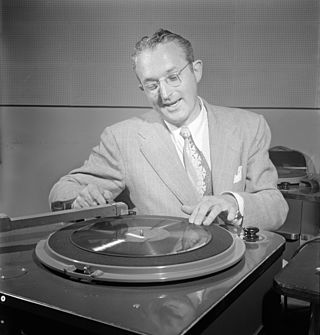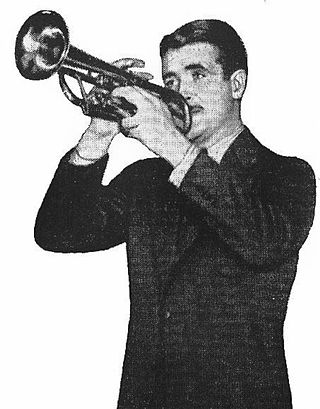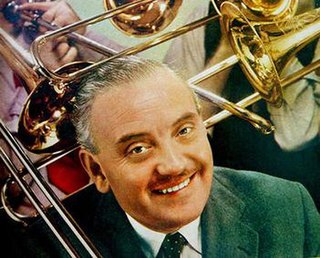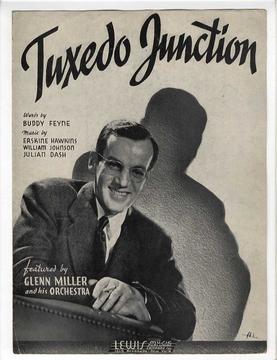
A big band or jazz orchestra is a type of musical ensemble of jazz music that usually consists of ten or more musicians with four sections: saxophones, trumpets, trombones, and a rhythm section. Big bands originated during the early 1910s and dominated jazz in the early 1940s when swing was most popular. The term "big band" is also used to describe a genre of music, although this was not the only style of music played by big bands.

Alton Glen Miller was an American big band founder, owner, conductor, composer, arranger, trombone player, and recording artist before and during World War II, when he was an officer in the US Army Air Forces. Glenn Miller and His Orchestra was one of the most popular and successful bands of the 20th century and the big band era. His military group, the Major Glenn Miller Army Air Forces Orchestra, was also popular and successful.
Swing music is a style of jazz that developed in the United States during the late 1920s and early 1930s. It became nationally popular from the mid-1930s. The name derived from its emphasis on the off-beat, or nominally weaker beat. Swing bands usually featured soloists who would improvise on the melody over the arrangement. The danceable swing style of big bands and bandleaders such as Benny Goodman was the dominant form of American popular music from 1935 to 1946, known as the swing era. The verb "to swing" is also used as a term of praise for playing that has a strong groove or drive. Musicians of the swing era include Duke Ellington, Benny Goodman, Count Basie, Cab Calloway, Jimmy Dorsey, Tommy Dorsey, Woody Herman, Harry James, Lionel Hampton, Glenn Miller, Artie Shaw and Django Reinhardt.

Thomas Francis Dorsey Jr. was an American jazz trombonist, composer, conductor and bandleader of the big band era. He was known as the "Sentimental Gentleman of Swing" because of his smooth-toned trombone playing. His theme song was "I'm Getting Sentimental Over You". His technical skill on the trombone gave him renown among other musicians. He was the younger brother of bandleader Jimmy Dorsey. After Dorsey broke with his brother in the mid-1930s, he led an extremely successful band from the late 1930s into the 1950s. He is best remembered for standards such as "Opus One", "Song of India", "Marie", "On Treasure Island", and his biggest hit single, "I'll Never Smile Again".

Ben Pollack was an American drummer and bandleader from the mid-1920s through the swing era. His eye for talent led him to employ musicians such as Benny Goodman, Jack Teagarden, Glenn Miller, Jimmy McPartland, and Harry James. This ability earned him the nickname the "Father of Swing".

Roland Bernard "Bunny" Berigan was an American jazz trumpeter and bandleader who rose to fame during the swing era. His career and influence were shortened by alcoholism, and ended with his early demise at the age of 33 from cirrhosis. Although he composed some jazz instrumentals such as "Chicken and Waffles" and "Blues", Berigan was best known for his virtuoso jazz trumpeting. His 1937 classic recording "I Can't Get Started" was inducted into the Grammy Hall of Fame in 1975.

Stanley Newcomb Kenton was an American popular music and jazz artist. As a pianist, composer, arranger and band leader, he led an innovative and influential jazz orchestra for almost four decades. Though Kenton had several pop hits from the early 1940s into the 1960s, his music was always forward-looking. Kenton was also a pioneer in the field of jazz education, creating the Stan Kenton Jazz Camp in 1959 at Indiana University.

The Dorsey Brothers were an American studio dance band, led by Tommy and Jimmy Dorsey. They started recording in 1928 for OKeh Records.
The Irish showband was a dance band format popular in Ireland from the mid-1950s to mid-1980s. The showband was based on the internationally popular six- or seven-piece dance band. The band's basic repertoire included standard dance numbers and covers of pop music hits. The versatile music ranged from rock and roll and country and western songs to traditional dixieland jazz and even Irish Céilí dance, Newfie stomps, folk music and waltzes. Key to a showband's popular success was the ability to perform songs currently in the record charts. Some bands also did comedy skits onstage.

George Edward Heath was a British musician and big band leader.

Gordon Lee "Tex" Beneke was an American saxophonist, singer, and bandleader. His career is a history of associations with bandleader Glenn Miller and former musicians and singers who worked with Miller. His band is also associated with the careers of Eydie Gormé, Henry Mancini and Ronnie Deauville. Beneke also solos on the recording the Glenn Miller Orchestra made of their popular song "In The Mood" and sings on another popular Glenn Miller recording, "Chattanooga Choo Choo". Jazz critic Will Friedwald considers Beneke to be one of the major blues singers who sang with the big bands of the early 1940s.

The Roseland Ballroom was a multipurpose hall, in a converted ice skating rink, with a colorful ballroom dancing pedigree, in New York City's theater district, on West 52nd Street in Manhattan.

"Tuxedo Junction" is a popular song written by Erskine Hawkins, Bill Johnson, and Julian Dash with lyrics by Buddy Feyne. The song was introduced by Erskine Hawkins & His Orchestra, a college dance band previously known as the Bama State Collegians. RCA released it in 1939 and it climbed to #7 on the American pop charts. The song was a No. 1 hit for Glenn Miller & His Orchestra in 1940.

A big band remote was a remote broadcast, common on radio during the 1930s and 1940s, involving a coast-to-coast live transmission of a big band.
William James Finegan was an American jazz bandleader, pianist, arranger, and composer. He was an arranger in the Glenn Miller Orchestra in the late 1930s and early 1940s.
The Rainbow Ballroom, at 38 E 5th Avenue, Denver, was a dance hall that was one of the best known dance halls west of the Mississippi, according to a 1946 Billboard article. Its capacity of 3,000 made it the largest indoor dance hall in Colorado during its 28 years of existence — from its opening day on September 16, 1933, to its closing day in 1961.

"Elmer's Tune" is a 1941 big band and jazz standard written by Elmer Albrecht, Dick Jurgens and Sammy Gallop. Glenn Miller and his Orchestra and Dick Jurgens and his Orchestra both charted with recordings of the composition.
The Rendezvous Ballroom was a large dance hall built in 1928, located on the beach of Balboa Peninsula in Orange County, Southern California, between Los Angeles and San Diego. The 1920s were the beginning of the heyday of public dancing to the music of popular bands and orchestras, and large ballrooms were built in most urban areas, and even on Catalina Island, 26 miles off the California coast.
Beverly Mae Wilson was an American country singer.

Casa Loma Ballroom is a historic dance hall in St. Louis, Missouri. It is located at 3354 Iowa Avenue in the city's Gravois Park neighborhood.














